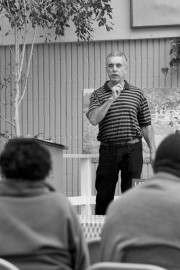Latino Heritage Month: Revolutionary painters celebrated

By Marilyn Fernando & Jandean Deocampo
The Guardsman
Across City College spaces, from art bars to the Southeast campus, appreciation for two dynamic Latino artists has culminated in lectures and exhibits that explore the abiding timelessness of their work.
“Frida and Diego: The Past is Present,” reflects the lasting effects of the culturally and artistically revolutionary couple on San Francisco’s art history at Madrone Art Bar in the Panhandle district–an unlikely place for City College to stake a claim in San Francisco’s art world. The mixed media exhibit explores the dynamic couple’s time in San Francisco through artists they were involved with here.
Carved into the side of a peeling Victorian, Madrone Art Bar sits at the helm of the Panhandle. The exhibit is hung on the right wall of the bar’s long, black room. The exhibit communicates a contemporary narrative of metropolitan artistry, with subjects as diverse as women’s studies and Chicano and African American inspired work.
Curator Anthony Torres strategically framed the body of the exhibit, placing photos of Rivera on both sides of the display like parentheses around a sentence, in an effort to suggest the Mexican muralist’s influence on the artists within. Kahlo maintains a presence in the art as well. Rupert Garcia’s “Frida Kahlo” is a stylized portrait of the artist.
Political and social issues are apparent in Art Hazelwood’s frenetic “Hoover Institute.” Hazelwood was recently involved in Occupy and protesting the Iraq War in his “activism art,” which recalls contemporary Chicano art. His work is likened politically to Rivera’s Communist ties as their work shares an upheaval of capitalism.
Chicana “narrative artist” Carmen Lomas Garza’s picturesque images, often laden with complacent interactions between Latino families, recall Rivera’s murals. Garza’s “Sandia fria, pedacito de mi corazón” illustrates interactions between the working class and socialist revolutionaries. Garza’s gouache on cotton paper medium has the visual softness of fresco murals.
If the photos of Rivera are parenthetical, then the larger portraits on either side of the exhibit are exclamation points in a Spanish phrase.
On the left side of the wall, three separate canvases titled “Frida Be You and Me” by Jeffrey Beauchamp make up a portrait of a solitary girl sitting in a painted world, mixing two globs of paint in her hands. Two of the canvases frame her action, giving us the two colors she used in separate palms, suggesting Kahlo’s creative process when painting.
She once said, “I paint self-portraits because I am so often alone, because I am the person I know best.”
On the right side of the painting, the image of Mary is literally pasted on the crown of a large display of oil paint and bright color. A product of two decades of work, Diane Roby’s “Tonantzin Redux” recalls Mesoamerican art and Spanish culture. “Tonantzin” is an Aztec title given to female deities and a “redux” is a return or throwback to an older version of something. The image of the Virgin Mary in this painting speaks great volumes about not only the evolution of art in Latin America, but of religion as well.
The exhibit is an accessible snapshot of this contagious style heralded by contemporary Chicano artists from Kahlo and Rivera.
“Great turnout” at lecture
A few days after the exhibit opened at Madrone Art Bar, a lecture on Diego Rivera’s “Pan American Unity” was given at Southeast Campus. The event brought attention to the opportunities granted to those from disadvantaged backgrounds and made a case for the school’s sustenance.
“If you don’t have it (education) in your family, how do you bootstrap yourself up to understand it?” said Will Maynez. “City College will give students a shot, especially those who don’t have a legacy of education in their families.”
Former physics lab manager turned unofficial guardian of “Pan America Unity”, Rivera’s largest contiguous mural, Maynez presented important milestones in Rivera’s art and time spent in San Francisco with his wife, Frida Kahlo, before an audience of 20 in the Alex Pitcher Community Room.
Maynez’s own heritage was a matter for presentation.
Maynez intends to preserve the “Unity” mural, increase its prominence and fund the project’s self-sufficiency in the form of a proposed Center for Pan American Unity, where the colorful oversized fresco would be preserved. Now located inside the Diego Rivera Theater, the piece contrasts the industrial advances and political activity of the 1940s against Latin American traditions.
“It wasn’t been like this very long at all. The desegregation of Mexican-Americans in the school system only took effect in 1947,” said Maynez.
“This (equality in education) didn’t happen overnight, it’s guys like this who made it possible,” said Maynez, recognizing the actions of Latino civil rights leaders like Cesar Chavez and Alex Pitcher.
Samuel Santos, 31, current Associate Dean of Student Activities, said “Will Maynez did a wonderful job with his presentation. I really appreciated learning about the mural in the Diego Rivera theater. I also enjoyed the great turnout of students.”
“My Latino heritage means an acknowledgment, celebration and recognition of the history, culture, food and art of my family – those living and those who’ve passed,” Santos said, crediting his heritage as a critical part of his education after attaining a BA in Mexican-American studies from the University of Texas.
The exhibit at Madrone Art Bar runs until Nov. 16. Complementing exhibit “Frida in San Francisco,” will be on display Oct. 1-31 at Ocean campus Gallery, Visual Arts Building, Room 119.
